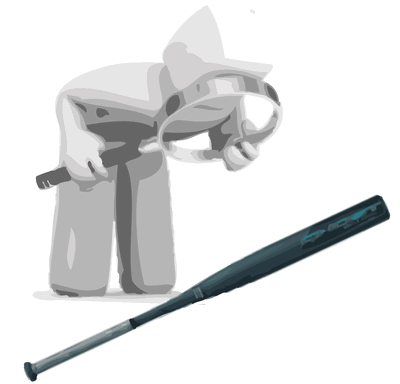- Is Bat Rolling Worth it?
*As long as the bat is composite bat rolling will help. SCAM ALERT- Anyone selling or rolling alloy bats is absolutely cheating the customer. Manipulated compression photos and videos are used to justify bat rolling alloy bats but any type of rolling (machine, heated, perpendicular, parallel or a super roll) will NOT help an alloy bat. (More Info on Bat Rolling Alloy Bats Click Here).
If you're new to bat rolling, you might be wondering, "Is bat rolling really worth it?" You may have heard about it in the dugout or at an after-game barbecue, but it seems no one has a clear answer. Well, I do.
Back in 2006, I stumbled upon bat rolling while browsing eBay and came across a rolling machine. Intrigued, I started researching, just like you're doing now. At the time, only two companies were offering bat rolling services online, but I was hesitant to send in my $300 bat. So, I bought a rolling machine, figuring I could resell it on eBay if it didn’t work.
The day my rolling machine arrived, I used it on my men's slow pitch Easton Synergy Extended bat and took it to the field that night. The results were shocking—the bat had more pop, and the ball was traveling significantly farther. That’s when I knew bat rolling was real and effective.
What started as a hobby quickly turned into a business. With over 86,000 bats rolled and the enduring success of Big Dawg, it’s clear that bat rolling works.

2. Does Bat Rolling Shorten a Bat's Life?
This is a question that can be debated. Some would say it is a fact that the bat's life is lost because of the breakdown of carbon fiber as a result of rolling. Others argue that an even break-in allows the bat to be more solid across the barrel without dead or hot spots. There is definitely a method to naturally break in

a composite bat: it involves soft toss, batting practice, or hitting off a tee. You would rotate the bat each strike of the ball until the recommended break-in is achieved. And this is where indecisiveness comes in; what is the recommended amount of hits to break-in a bat? Some bat companies say they are hot out of the wrapper, which is not truthful; composites bats do have a break in period. Other bat companies will give a recommended number of ball strikes, such as the Anderson Bat Company. There is a top-level national Little League coach that I talked to who swears natural break-in gets the bats hotter than a bat rolling but was worried about an even break-in across the barrel. In my experience, there is no difference, but lack of time to hit 2000-3000 balls can be a HUGE factor for some people. Rolling cuts out the time of breaking in a bat, which can come in handy in a pinch or if you want the bat to perform at peak level from the get-go. A rolled bat has had all the composite material broken in across the bat evenly due to the bat rollers consistent points of pressure. A natural break-in could cause a bat to have hot spots which the composite is more crushed in one spot because of repetitive strikes. This hot spot could also be called a weak spot (where a bat is more likely to break sooner if hit). The dead spots would be a non-issue with rolling. In theory, Dead spots are where the composite material would not be broken up, caused by missing a spot while naturally breaking in the bat. This would cause the bat to have less pop when struck in that dead spot. Also, batting practice will inevitably cause your bat to get scuffed up marked up, and believe it or not; a bat can be thrown out of play for looking too "worn."
- Can Bat Rolling be detected?
This is a question I get regularly. My answer usually is, "Yes, if the bat has not been rolled correctly." There is quite a bit of information on an incorrectly rolled bat. As I searched through forums and blogs, I saw stories of "ridges" or "lines" on a bat that were signs of bat rolling. These "ridges they speak of are caused by improperly rolling a bat (too much pressure or incorrect heating). Over the years, I have fixed other companies' mistakes with some degree of success. Another way to tell if a bat has been rolled is the graphics peeling off the bat in odd places, normally where the end of the rollers meet the bat. Another way to tell if a bat has been rolled is by residue from bat roller material left behind on the bat. And this can cause "roller marks" to be left on the bat. These can be wiped off with a cleaning product most of the time, but there are some bats where the marks are still visible to the trained eye. So the answer to the question is yes and no. If you get a bat rolled correctly, to my knowledge, there is no way to detect it has been rolled other than compression loss.

- Is Bat Rolling illegal?
Bat rolling is illegal in most sanctioned baseball, softball, and fastpitch associations. The sanctions rely on a testing facility to test each bat for allowable limits. The technicians test these bats by performing bat rolling. So this means bat rolling is the evaluation to reach the standard of bat performance guidelines; And this is a fantastic irony. So why not perform bat rolling on your bats? The bat is evenly broken-in across the entire barrel just as the test facility’s bats.
- Best Bat Rolling Service?
14 years ago, there were three companies offering bat rolling services: World's hottest bats (resent new owner), CompositeBatRolling.com (They are no longer around), and Big Dawg Bat Rolling, and within the past 14 years, there have been over 100 bat rollers advertising services on EBay, the Internet, and Craigslist. That means this is a relatively new service, and experience is a commodity when choosing a bat roller. Many of the stories of detectable rolling I mentioned above come directly from these newer bat rollers who do not have the skill that comes with years of rolling. I have seen some odd things come out of the bat rolling industry: rolling bats with caps off, heat rolling all bats, claims that bat rolling alloy bats help, and 50ft distance claims from rolling. Some of these claims are buck wild, but most of them make me cringe. One company even offers a "super roll" and charges more money for what should be completed by a normal bat rolling service. All these claims are pure marketing hype and propaganda.
What Big Dawg brings to the table is 18+ years of experience and multiple techniques we utilize in the break-in process.
-Basic bat rolling machine- perpendicular rolling followed parallel (an industry standard we pioneered).
-Basic bat rolling machine with upgraded rigid rollers installed- some bats need a harder material to complete the break-in process, i.e., Bbcor.
-Electric bat rolling machine- allows for a more extensive parallel roll.
-NBI Natural break-in- Some outer shells cannot handle the elongated pressure points of a 6-inch roller.
-Heated bat rolling- Heat helps the outer shell flex more on some composites. Multiple heatings (followed by rolling) and coolings can also break up inner composite layers on some bats. We utilize a digital thermostat bat oven and a laser temperature gun to accurately heat our bats (not a heat gun like our competitors).
-BCT Barrel Compression Technique- Some bats need extreme pressure that bat rolling alone cannot offer in order to break up the composite.
Our knowledge database of techniques and composite materials is the most extensive in the nation.
I am definitely biased, but I know what Big Dawg brings to the table; and we are, without question, the best bat rolling service for you- We guarantee it!
4 Comments
If you believe your bat is not fully broken in then we can perform our Ultimate Break-in to get it there, even a used bat.
Axe bats roll just the same as any other bat, all side are rolled.
Any experience with Axe bats? Rolled on just one side or the other non used side as well?
Can I have my daughters bat rolled even though we have already started the breaking in process? She may have 200 swings of progressive hitting on it already. Thanks for and info